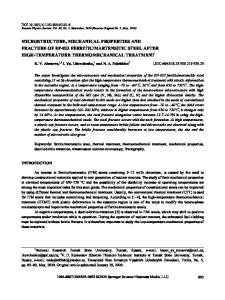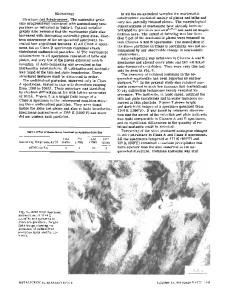Microstructure and Mechanical Properties of Martensitic High-Strength Engineering Steel
- PDF / 3,371,338 Bytes
- 12 Pages / 594 x 792 pts Page_size
- 78 Downloads / 397 Views
MICROSTRUCTURE AND MECHANICAL PROPERTIES OF MARTENSITIC HIGH-STRENGTH ENGINEERING STEEL M. V. Maisuradze,1 M. A. Ryzhkov,2 and D. I. Lebedev3
UDC 669.15
A promising martensitic steel with good hardenability is studied. In the cooling rate range 0.1–30°C/sec and the only transformation recorded by a dilatometer starts at an M s temperature of 355 ± 10°C. Microstructure and mechanical properties of the steel studied are analyzed after various heat treatment regimes: cooling from the austenitizing temperature at various rates (from 0.02 to 20°C/sec), austempering at 280–380°C, and oil quenching and tempering at 200–600°C. It is shown that a 1000-fold change in the cooling rate has a weak effect on steel strength. Bainitic transformation in the steel in question occurs in the martensitic transformation temperature range, which leads to a reduction in impact strength compared with a martensitic microstructure both after slow cooling and isothermal hardening. Keywords: steel, martensite, bainite, microstructure, mechanical properties, strength, ductility, impact strength, heat treatment.
The stability of steel supercooled austenite is a key feature in the selection of material for producing workpieces and components of a prescribed standard size [1, 2]. This especially concerns large components and objects of variable cross section [3, 4]. In the first case poor supercooled austenite stability leads to formation of undesirable microstructural components within the core of an object (ferrite, pearlite, upper bainite) that have an unfavorable effect on the steel mechanical properties [5]. In the second case poor steel hardenability leads to formation of various areas of an object with various structural components that may lead to object deformation on cooling during heat treatment as a result of non-simultaneous conversion of supercooled austenite in different areas of a object with various volumetric effects [6]. These difficulties may be avoided if for critical large components and objects of complex shape (rolling mill rolls, turbine rotors, shafts, axes, aircraft chassis struts, etc.) steel is used capable of forming a uniform structure at low temperature for supercooled austenite transformation products over a wide range of cooling rates (up to cooling in still air). Currently there is a limited range of steels that would satisfy the above-mentioned condition. Steels with good supercooled austenite stability (martensitic class according to the L. Guinier classification) (25Kh2N4МА, 25Kh2N4VА, 38KhN3МFА) [7, 8], and also low-carbon martensitic steels (12Kh2G2NМFТ, 15Kh2G2NМFBА, 27Kh2G2NМFBА) [9, 10]. In the first case in spite of a high content of expensive alloying elements it is not possible to obtain a uniform martensitic structure or a mixture of martensite and lower bainite with air cooling of components with cross section of more 100–150 mm. In the case of low-carbon martensitic steels presence of strong carbide-forming elements (vanadium, niobium, titanium) complicates the production process for melting, incre
Data Loading...











